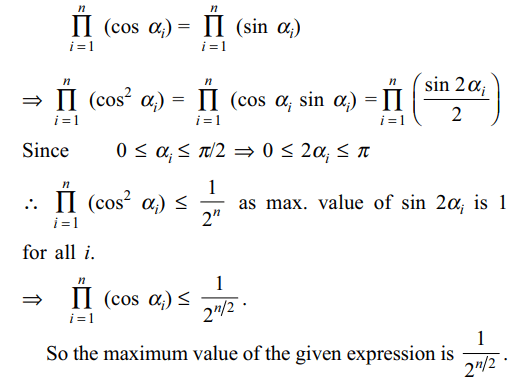1. \[ \begin{bmatrix}\cos\left(\theta+\alpha\right) & \sin\left(\theta+\alpha\right) & 1 \\\cos\left(\theta+\beta\right) & \sin\left(\theta+\beta\right) & 1 \\\cos\left(\theta+\gamma\right) & \sin\left(\theta+\gamma\right) & 1\end{bmatrix}\]
is independent of
a) \[\alpha\]
b) \[\beta\]
c) \[\gamma\]
d) \[\theta\]
Explanation: Differentiating the given determinant w.r.t. \[\theta\]
 we get
we get
2. If \[\theta\] and \[\phi\] are acute angles such that \[\sin\theta=1/2\]
and \[\cos\phi=1/3\] , then \[\theta + \phi\] lies in
a) \[]\pi/3,\pi/2[\]
b) \[]\pi/2,2\pi/3[\]
c) \[]2\pi/3,5\pi/3[\]
d) \[]5\pi/6,\pi[\]
Explanation:


3. The value of \[\tan3\alpha\cot\alpha\] cannot lie in
a) ] 0, 2/3 [
b) ] 1/3, 3 [
c) ] 4/3, 4 [
d) ] 2, 10/3 [
Explanation:
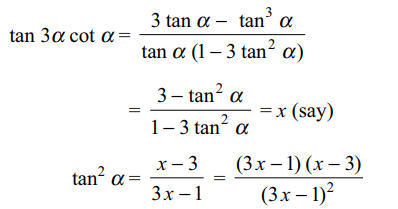

4. For a given pair of values x and y satisfying
\[x=\sin\alpha, y=\sin\beta\] , there are four different values of
\[z=\sin\left(\alpha+\beta\right)\] whose product is equal to
a) \[x^{2}-y^{2}\]
b) \[x^{2}+y^{2}\]
c) \[\left(x^{2}+y^{2}\right)^{2}\]
d) \[\left(x^{2}-y^{2}\right)^{2}\]
Explanation:


5. If \[0< A<\pi/2\] the value of the expression
\[\frac{\tan A}{ 1 -\cot A}+\frac{\cot A}{1-\tan A} - \sec A cosec A\]
is equal to
a) -1
b) 0
c) 1
d) \[\sin A+\cos A\]
Explanation: The given expression is equal to
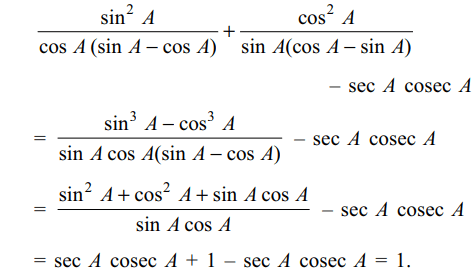
6. If \[a^{2}-2a\cos x+1=674\] and \[\tan \left(x/2\right)=7\] then the integral value of a is
a) 25
b) 49
c) 67
d) 74
Explanation:
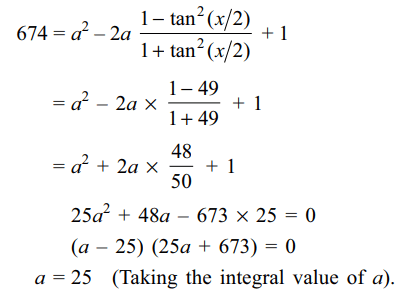
7.If \[\sin 2x=\alpha-1\] and \[\cos2x=\beta-1\] , then the
value of \[\frac{\sec^{2}x\left[\left(\cos^{2} x-\sin^{2} x\right)-2\sin x\cos x\right]}{1+\sin 2x}\]
is equal to
a) \[2\left(\alpha-\beta\right)\]
b) \[\frac{2}{\alpha}-\frac{2}{\beta}\]
c) \[\frac{2}{\beta}-\frac{2}{\alpha}\]
d) \[2\left(\alpha+\beta\right)\]
Explanation: The given expression can be written as
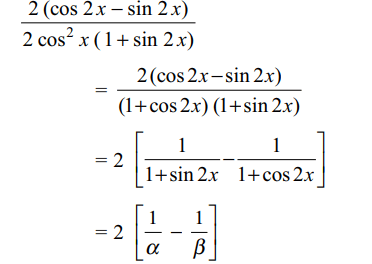
8. The value of the expression
\[\frac{1}{\cos290^{\circ}}+\frac{1}{\sqrt{3}\sin 250^{\circ}}\]
is equal to
a) \[\sqrt{3}/4\]
b) \[4/\sqrt{3}\]
c) \[2/\sqrt{3}\]
d) \[\sqrt{3}/2\]
Explanation: The given expression is equal to
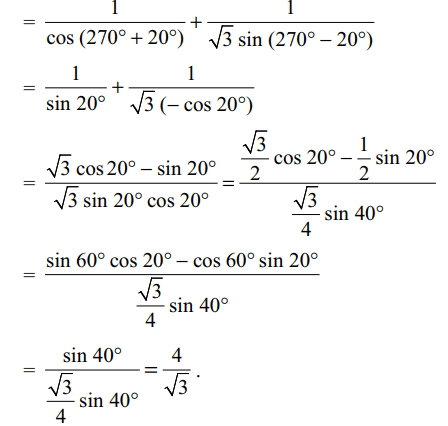
9. Let \[f\left(\theta\right) =\sin\theta\left(\sin\theta+\sin3\theta\right)\] , then \[f\left(\theta\right) \]
a) \[\geq\] 0 only when \[\theta \geq0\]
b) \[\leq\] 0 for all real \[\theta \]
c) \[\geq\] 0 for all real \[\theta \]
d) \[\leq\] 0 only when \[\theta \leq0\]
Explanation:


10. The maximum value of \[\left(\cos \alpha_{1}\right)\left(\cos \alpha_{2}\right)...\left(\cos \alpha_{n}\right)\]
under the restriction \[0\leq \alpha_{1},\alpha_{2},....,\alpha_{n}\leq \pi/2\]
and \[\left(\cot \alpha_{1}\right)\left(\cot \alpha_{2}\right)...\left(\cot \alpha_{n}\right)=1\] is
a) \[\frac{1}{2^{n/2}}\]
b) \[\frac{1}{2^{n}}\]
c) \[\frac{1}{2n}\]
d) 1
Explanation: From the given relations we have
